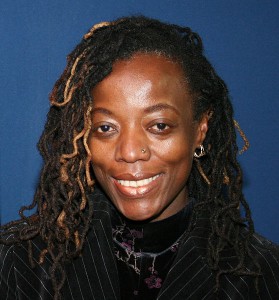Biography

In 1959, Tsitsi Dangarembga was born in Rhodesia, now called Zimbabwe, in the town of Mutoko. She spent her early childhood, ages two through six, in Britain. She began her education in a British school but after returning to Rhodesia with her family, she concluded her early education, her A-levels, in a missionary school in the City of Mutare (see Colonial Education). Later, she went back to Britain to attend Cambridge University where she pursued a course of study in medicine. Dangarembga was not destined to stay in Britain; after becoming homesick and alienated, she returned to her homeland of Rhodesia in 1980 just before it became Zimbabwe under black-majority rule.
She continued her educational pursuits in Rhodesia and began a course of study at the University of Harare in psychology. During her studies, Dangarembga held a job at a marketing agency as a copywriter for two years and was a member of the drama group affiliated with the university. This is where her early writing was given an avenue for expression. She wrote many of the plays that were put into production at the university. In 1983 she directed and wrote a play entitled “The Lost of the Soil”. She then became an active member of a theater group called Zambuko. This group was directed by Robert McLaren. While involved in this groups she participated in the production of two plays, “Katshaa!” and “Mavambo.”
While involved in theater she also explored prose writing. In 1985, she published a short story in Sweden entitled “The Letter” and in 1987, she published a play in Harare entitled “She No Longer Weeps.” Her real success came at age twenty-five with the publication of her novel Nervous Conditions. This novel was the first to be published in English by a black Zimbabwean woman. In 1989, Nervous Conditions won her the African section of the Commonwealth Writers Prize (see Postcolonial Novel). Prior to this award she had won a second prize in a short story competition of the Swedish aid-organization, SIDA. After Nervous Conditions was published in Denmark, she made a trip there in 1991 to be part of the Images-of-Africa festival (see Postcolonial Performance and Installation Art). Dangaremba continued her education in Berlin at the Deutsche Film und Fernseh Akademie where she studied film direction. While in school she made many film productions, including a documentary for German television. She then made the film entitled Everyone’s Child in 1996. It was shown world wide at various festivals, including the Dublin Film Festival. In 2006, she published The Book of Not: A Sequel to Nervous Conditions.
Nervous Conditions
“The condition of native is a nervous condition.”
Nervous Conditions is a partially autobiographical story of Tambu, a young girl who lives on an impoverished Rhodesian farm during the late 1960s. The death of Tambu’s brother forces her to live with Babamukuru, her uncle who has been educated in the west, and become the provider for her family. She quickly accepts this situation because it offers her the opportunity of missionary schooling and the knowledge of a western educated family. Tambu has great aspirations for her personal education despite the obstacles that stand in her way: race, class and sex. The topics of education and its relation to gender are important facets of this novel (see Gender and Nation). Education is used as a route to power by many characters in the novel, most importantly Babamukuru. The novel also follows the story of Tambu’s cousin who has anorexia, an illness not usually associated with African countries. This disease is used in the novel as a form of control for Tambu’s cousin who is torn between two cultures, that of her home, Rhodesia and that of England. The novel also discusses the many facets of poverty and the effects that it has on people. Poverty affects each character in the novel creating in each of them a different nervous condition (see also Frantz Fanon, Anglophilia).
Selected Bibliography
- Buck, Claire. The Bloomsbury Guide to Women’s Literature, New York: Prentice Hall General Reference, 1992. 247.
- Creamer, Heidi. “An Apple for the Teacher?: Femininity, Coloniality and Food in Nervous Conditions,” in Anna Rutherford, ed. In to the Nineties. New South Wales: Dangaroo Press, 1994. 344-360.
- Dangarembga, Tsitsi. Nervous Conditions, Seattle: Seal Press, 1989.
- Vizzard, Michelle. “Of Mimicry and Woman’ Hysteria and Anti-colonial Feminism in Tsitsi Dangarembga’s Nervous Conditions,” Journal of the South Pacific Association for the Commonwealth Literature and Language Studies. 1993.
Links to Related Sites
Nervous Conditions synopsis and information
http://www.wmich.edu/dialogues/texts/nervousconditions.html
Postcolonial pathology in Nervous Conditions
http://pmc.iath.virginia.edu/text-only/issue.994/bahri.994
Information about Everyone’s Child
http://newsreel.org/nav/title.asp?tc=CN0028
Author: Rebecca Grady, Fall 1997
Last edited: May 2017
4 Comments
The information is excellent and really helpful. Thank you for good post. I like this.
i like your novel she no longer weeps
All the book really good..
Pingback: Tsitsi Dangarembga – Beyond the Single Story